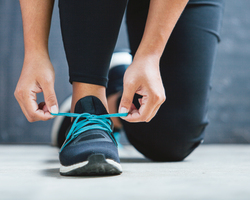
Running is simply a matter of putting one foot in front of the other.
But if you're considering running for exercise and you don't start off on the right foot—so to speak, anyway—you could be injured.
Here are some safety tips:
Proper preparation
First, check with your doctor to make sure running is a safe exercise for you.
Next, you'll need a pair of quality running shoes. According to the American Council on Exercise (ACE), running shoes that fit well may help prevent shin splints, blisters and sore muscles.
Your shoes should provide good shock absorption, stability and cushioning. Just keep in mind that shoes eventually wear out. The American Academy of Orthopaedic Surgeons (AAOS) reports that 60% of shoes' shock absorption is lost after 250 to 500 miles of use. If you run up to 10 miles per week, consider replacing your shoes every 9 to 12 months.
After you're laced up, do a five-minute warm-up followed by some stretching. It's also important to stretch after your run.
The right environment
When possible, run on smooth, unobstructed surfaces. Asphalt and dirt are preferable to concrete. And since running on hills may increase stress on your ankles and feet, try to stick to level surfaces.
In warm weather, run early in the day or later in the evening—but not after dark. At dawn or dusk, wear reflective clothing. And try to avoid running when and where pollution levels are high.
Slow and steady
Now that you're ready, hit the road—but slowly.
If you haven't been exercising at all, you may want to start out with a week or two of regular walking and ease into running after that. Your doctor can help you decide on a safe way to start a running program.
Once you start running, you'll want to increase your mileage gradually—no more than 10% per week, according to the ACE. And you should take regular days off between your runs—especially if you're feeling discomfort.
For proper form, the ACE advises:
- Keeping your head level and avoiding bouncing.
- Keeping your shoulders down and relaxed.
- Finding a footstrike that's natural for you and focusing on soft and quiet ground contact.
To make up for fluid loss, the AAOS recommends drinking 10 to 15 ounces of fluid 10 to 15 minutes before your run and again every 20 to 30 minutes during your run. The group also says to weigh yourself before and after a run and drink 1 pint of fluid for every pound lost.
If you're injured
Even if you take every precaution, injuries are possible. In many cases, treating your injury at home with the RICE method for at least 48 hours may be appropriate. RICE stands for:
Resting the affected area.
Icing the injury.
Compressing the injury (with a bandage or other compressive device).
Elevating the injury.
But, according to the American Orthopaedic Foot & Ankle Society, you should call a doctor if:
- Your injury causes severe pain, significant swelling or deformity.
- You can't tolerate weight on the area.
Reviewed 8/1/2024